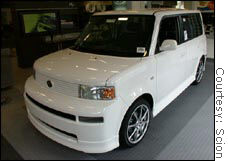NEW YORK (CNN/Money) - Half of them are too young to drive -- let alone buy cars -- but some automakers are going to extremes to reach the so-called Generation Y.
Toyota even created an entirely new brand aimed at the demographic bump in car shoppers coming after Generation X.
Those born between about 1977 and 1994 are the most important group of new car buyers since baby boomers started breaking their parents' buying habits to buy Volkswagens and Japanese imports in the 1960s and '70s. By some estimates Gen Y is larger than the famous Baby Boom generation. They are expected to be buying one out of every four new U.S. vehicles purchased by 2010. Gen Y's membership is estimated at somewhere between 85 and 100 million, as much as twice as large as Generation X.
 |
|
| Toyota Motor Corp. has created a whole new brand, Scion, to try to sell to young car buyers. |
The most radical effort so far is by Toyota Motor Corp., which created an entirely new brand -- Scion -- aimed at the youth market. Scion started selling its first vehicles at California dealerships last month.
John Pangilinan, 23, works in an after-market car parts shop in California and he's just the sort of buyer Toyota had in mind when it created "Scion." He said he recently bought one of the first the Scion xB's, turning in a VW Eurovan he had bought only a year earlier.
"I didn't really consider any other car. I was looking forward to this car," he said. "I like that it's small and boxy. It's different."
In an attempt to reach Pangilinan and his peers the designs automakers are coming up with are often boxier than the cars preferred by their parents and older siblings. The theory is that Gen Y car shoppers are interested lots of space for friends and equipment and a low price tag.
Pangilinan says he would have bought the new car even if it had had the Toyota rather than the Scion brand on it, but company officials insist they needed to go through the expense and trouble of creating a new brand if they were to compete for the new generation of younger buyers.
"When we asked the customers we're targeting at Scion what do you think about Toyota, they said it's a mainstream company that's for someone else," said Jim Farley, vice president at Scion.
Among the things that differentiate Scion from other brands is the use of alternative media, such as concert sponsorship rather than mainstream television ads, and no stereo system in the car when it arrives in the showroom. That makes it cheaper and easier for buyers to upgrade to their own high-end system.
"Dealers don't have to throw audio units away and the customer doesn't have to pay twice," Farley said.
 |
|
| Honda Element is designed for the youth market but has a more typical spread on age of its buyers. |
Farley said he sees Volkswagen and Honda as Scion's main competitors. Some lower-end luxury models do well in this market, too, so luxury brands, including Toyota's own Lexus are counted among Scion's competitors, said Farley. This is in spite of the fact that Scion's prices are a bit lower than prices for some of the smaller Toyota cars and far closer to low-priced Korean imports.
"The affluent-minded kids don't have the money to buy what they want to buy now," he said. "They want all the good stuff but right now they're on a subcompact budget. We're affordable but if we're seen as a cheap car, we're in big trouble."
Evidently, Gen Y members aren't the only ones interested in lots of space for less money. Honda's Element is similar to the Scion Xb van and was likewise targeted at the Gen Y sweet spot. As it turns out, according to sales data from R.L. Polk and J.D. Power and Associates, the age distribution of Element buyers closely matches the average for all vehicles.
Not everyone trying that hard
The U.S. automakers insist they're in good position to market to Gen Y with the brands they have. GM is gearing marketing of its Saturn brand towards the younger buyer, as well some of its Pontiac models. It is also preparing to roll out two new vehicles aimed at the youth market under the Chevrolet brand -- the Avevo, a subcompact sedan built by the Korean automaker Daewoo that GM recently purchased, and the Equinox compact sport/utility vehicle.
| Related stories
|

|
|
|
|
"You need a favorable cost structure to make these profitable," said Paul Ballew, executive director for market and industry analysis at GM. "The transaction price will be the in low teens. This is a price sensitive area."
Ford executive point to strong sales of three of its top selling vehicles to the under-30 market -- the Ford Focus subcompact, the Ford Escape small SUV and the Mustang sports car, as a sign they're in fine position with Gen Y buyers.
"I suspect you couldn't find three products at any other brand that attract so many young buyers," said Ford spokesman George Pipas. "To go to additional expense of creating an additional brand name isn't necessary if you're already connecting with this group."
But Walter McManus, automotive analyst for J.D. Power and Associates, said Ford has those large Gen Y sales because those are three inexpensive, mass market vehicles, not because they're connecting particularly well with the youth market. He said that Ford's share of Gen Y is still a bit below its overall market share, unlike Honda, which has almost twice the market share with the under-30 buyer than it does with the overall market.
Click here for a look at auto stocks
"Ford actually is a little better than 10 years ago (in selling to those under 30)," said McManus. "But they have more to be concerned about than Honda."

|

